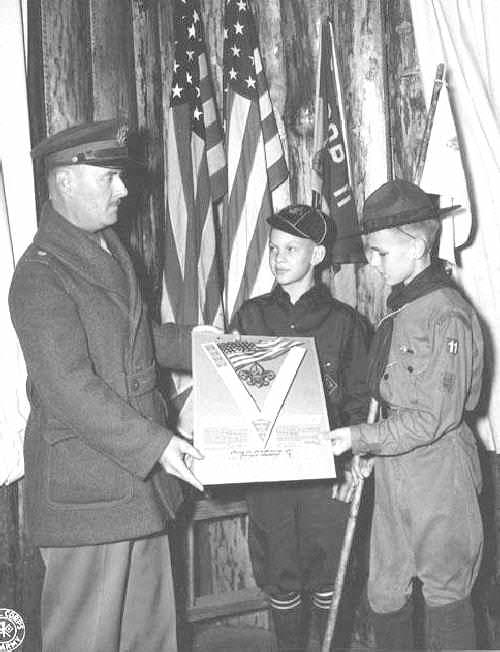
Boys' Historic Uniforms: The 1940s

Figure 1.--All the uniformed youth groups played a role in World War II. This U.S. Army officer in 1942 is awarding a National War Service "Victory" certificate to members of Fourt Benning, Georgia Boy Scout Troop 11, composed of sons of U. S. Army officers stationed at Fort Benning. Interestingly, the Hitler Youth did not have separate units for officers' sons. Note boy the Cub and Boy Scout are wearing the knickers uniform. Click on the image for a fuller discussion.
|
|
The 1940s was another war decade. NAZI Germany and Soviet Russia after sining an allince, launched World War II by invading Poland (September 1939). As destructive ad bloody as World war I had been, Workd War II was even worse. The War had such a major imapct on youth movements that we must consider the 1940s in two separate sections, the war years (1938-45) and the post war years (1945-49). Youth Groups, especially the Hitler Youth, played an important role in the German war effort, eventually involving very young boys in combat. Youth also were active in the Allied nations, even the occupied countries where they often supported the Resistance. The Germans outlawed Scouting first in Germany before the wr and then in several occupied cuntries during the war. The Scoits were especially active in America and Britain. After the Germans surrenderd in 1945, Scouting became the dominate youth movement, expept in the countries occupied by the Red Army where it was prohibited and new national Young Pioneer groups were founded.
The War years was a caotic period for boys youth groups. Germany invaded Poland in September 1939. The Hitler youth were mobilized for the war effort, especially after German began suffering reverses in the Soviet Union December 1941. I'm not sure how the uniform chaged during this period. The Hitler Youth played a major role in the German effort to resist the Allied bombing campaign which began serious raids into Germany in 1942. The German NAZIs occupied most of Western Europe and supressed Scouting. They attempted to promote nationalist groups in Nordic countries. Scouts and other youth groups in America and Briotain played a less direct, but none-the-less important role. In the occupied countries, Scours often participated in the Resistance. By 1945 the NAZIs had been driven out of the occupied countries. Scouts reappeared in the West. Scouters in the Eastern European countries conqured by the Soviet Red Army attempted to reorganize Scouting.
After being supressed by the NAZIs and Itlalian Fascists, Scouts in liberated Western Europe, including Fermany and Italy, quickly reorganized after liberation. In Eastern Europe the Communists looked on Scouting with the same suspision as the NAZIs. Scouts reorganized briefly in some countries during 1945-47, but as the Communist Governments took full control the Scouts were outlawed. Scout leaders in many cases were arrested. Children had to join the communist youth movement, the Young Pioneers. The BSA in 1945 changes Cubbing to Cub Scouting. The BSA in 1948 holds the first Wood Badge course at Schiff, 2nd course held at Philmont. James West in 1948 passes away. The BSA in 1949 establishes Explorer Scouting from the Senior Scouting program The BSA in 1949 lowers age limits lowered to 8 for Cub Scouts, 11 for Boy Scouts, and 14 for Explorers. The lowering of the age for Cubs significantly expands BSA membership. Scouts came together for the first year in 1947 for the 6th World Jamboree in Molsson, France. It was attended by 1,151 American Scouts for a total of 24,000 Scouts from 38 countries.
Uniforms
Some uniformed boys' organizations had employed long trousers as part of a uniform. I believe, however, that long trousers had been used as a winter uniform. The Hitler Youth, for example, wore longs duuring the winter. The Scout uniform is changed forever in 1943 when the BSA introduces long trousers and a Scout cap for Boy Scouts and in 1947 long pants were introduced for Cubs. The BSA is the first Scout association to my knowledge to introduce long trousers as part of a year-round uniform.
HBU

Navigate the Historic Boys' Uniform Chronology Pages:
[Return to the Main chronologies page]
[The 1900s]
[The 1910s]
[The 1920s]
[The 1930s]
[]
[The 1950s]
[The 1960s]
[The 1970s]
[The 1980s]
[The 1990s]
[The 2000s]
Navigate the Historic Boys' Uniform Web Site:
[Activities]
[Biographies]
[Chronologies]
[Countries]
[Essays]
[Garments]
[Organizations]
[Religion]
[Other]
[Introduction]
[Bibliographies]
[Contributions]
[FAQs]
[Questions]
[Unknown images]
[Boys' Uniform Home]
Navigate the Historic Boys' Uniform Web organization pages:
[Boys' Brigade]
[Camp Fire]
[Hitler Youth]
[National]
[Pioneers]
[Royal Rangers]
[Scout]
Created: November 15, 1998
Last updated: 4:26 PM 5/30/2008



